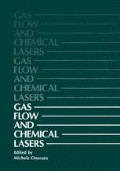Abstract
The great diversity of thermo-and gasdynamic states and substantial departures from thermodynamic equilibrium typical of molecular gas flow lasers specify the methods of the optical diagnostics of such systems. The most important characteristic of the inverse gas laser medium is the unsaturated gain coefficient, a, of unit length of the active medium, which is connected with the integral gain coefficient of the entire length of the active medium, k = Pout/Pin, by the relation k = = exp[(α−δ)Lo] where δ is the coefficient of distributed losses (scattering) and Lo is the active medium length. Except for the so-called method of calibrated losses, the gain coefficient is usually measured by passing through the active medium a monochromatic radiation with the same quantum transitions as those in the induced radiation of the medium. The remainder parameters of the diagnostic laser medium and of that tested (i.e. density, temperature, composition) may in this case differ substantially. The analysis of the conditions typical of gasdynamic and electric-discharge CO2 lasers shows that the effective widths of the tested and diagnostic line contours may differ several-fold. This leads to a partial overlapping of lines and, consequently, to certain errors in the measurements of gain. Also, an important characteristic of the inverse molecular laser medium is the temperature of a particular vibrational state of the molecules. That the vibrational and rotational temperatures could be determined, the distributions of the gain (absorption) coefficient over a wide range of separate IR-spectrum lines are measured. The paper presents an analysis of some reasons for the errors occurring in determination of the gain coefficient for molecular gas laser media and describes the methods allowing simultaneous measurements of the vibrational and rotational temperatures in a CO2 laser medium by means of a tuned diagnostic laser with high time resolutions.
Access this chapter
Tax calculation will be finalised at checkout
Purchases are for personal use only
Preview
Unable to display preview. Download preview PDF.
References
G. Herzberg, “Molecular spectra and molecular structure,” parts I (2nd ed.) and II, D. Van Nostrand Co., Inc., Princeton ( 1950; 1945 ).
S.S. Penner, “Quantitative molecular spectroscopy and gas emissivities”, Addison-Wesley Pubi. Co., Inc., Reading, Massachusetts (1949).
M.A. Elyashevich, “Atomic and molecular spectroscopy”, Fizmatgiz, Moscow (1962).
A.R. Strilchuk and A.A. Offenberger, High temperature absorption in CO2 at 10.6 u, Appl. Opt. 13: 2643 (1974).
R.I. Soloukhin and N.A. Fomin, Resonance 10.6 u CO2 absorption in a shock wave, Zh. Prikl. Mekh. Tekhn. Fiz. No. 1, 42 (1977).
R.I. Soloukhin and Yu.A. Yacobi, Comments on optical gain measurements, Zh. Prikl. Mekh. Tekhn. Fiz. No. 3, 3 (1974).
Q.V. Achasov and D.S. Ragosin, Study of the CO2-laser beam absorption in N20, in: “Thermophysical processes in power designs,” S.A. Zhdanok and Yu.V. Porodsinsky, ed., p. 12, Heat and Mass Transfer Institute, Minsk (1982).
V.L. Kolpashchikov, R.I. Soloukhin and T.A. Syroyezhko, Spectrum characteristics of thermally nonuniform resonance-amplifying media, Zh. Prikl. Spektr. 29: 1006 (1978).
P.V. Avizonis, R. Dean and R. Grotbeck, Determination of vibrational and translational temperatures in gasdynamic lasers, Appt. Phys. Lett. 23: 375 (1973).
O.V. Achasov, S.A. Labuda, R.I. Soloukhin and N.A. Fomin, Rotational and vibrational temperature measurements using tunable CO2-laser, Fiz. Gore-niya i Vzryva No. 6, 57 (1979).
N.A. Fomin and R.I. Soloukhin, “Laser diagnostics of molecular states in vibrationally excited gas flow systems,” in: Proc. Colloque International Bertelot-VieTTle-Mallard-Le Chatelier, pubi. by Sect. Franc. Comb. Inst., p. 539, Bordeaux (1981).
V.N. Croshko, N.A. Fomin and R.I. Soloukhin, Population inversion and gain distribution in mixed flow systems, Acta Astronautica 2: 929 (1975).
A.Y. Krauklis, Y.N. Croshko, R.I. Soloukhin and N.A. Fomin, Generation regimes in GDL with thermal excitation and supersonic flow mixing, Fiz. Goreniya i Vzryva No. 5, 792 (1976).
N.N. Kudriavtsev, S.S. Novikov and I.B. Svetlichnyi, Experimental determination of carbon dioxide (001) level temperature in a nonequilibrium flow of CO2+N2+H20 (He) mixtures, Fiz. Go-reniya i Vzryva No. 2, 205 (1977).
N.N. Kudriavtsev, S.S. Novikov and I.B. Svetlichnyi, Method of vibrational temperature measurements in gasdynamic CO2-lasers, Quant. Electr. 6: 690 (1979).
N.N. Kudriavtsev, S.S. Novikov and I.B. Svetlichnyi, CO2 vibrational temperature measurements in CO+N20 gasdynamic laser, Acta Astronautica 6: 391 (1979).
N.N. Kudriavtsev and S.S. Novikov, A study of infrared radiation of vibrationally excited CO in the 4.7 pm band and CO2 in the 4.3 pm and 2.7 pm bands, Revue Phys. Appl. 16: 49 (1981).
R.I. Soloukhin, Yu.A. Yacobi and E.I. Viazovich, Fast tunable CO2-laser design, Soviet Patent Bull. No. 11, Patent No. 594842 (1979).
Yu.A. Yacobi, Scanning of laser generation spectra by the intercavity space filtration, Quant. Electr. 8: 555 (1981).
P.V. Grigoriev, S.A. Murikov, R.I. Soloukhin and Yu.A. Yacobi, Rotational temperature measurements in GOL, Chem. Phys. (Russian) No. 2, 216 (1982).
S.P. Vagin, S.S. Vorontsov, R.I. Soloukhin, A.A. Shepelenko and Yu.A. Yacobi, Panoramic spectroscopy of lengthy lasing media, Zh. Priki. Spektr. 29: 224 (1978).
Author information
Authors and Affiliations
Editor information
Editors and Affiliations
Rights and permissions
Copyright information
© 1984 Plenum Press, New York
About this chapter
Cite this chapter
Soloukhin, R.I. (1984). Flow Laser Diagnostic Techniques. In: Onorato, M. (eds) Gas Flow and Chemical Lasers. Springer, Boston, MA. https://doi.org/10.1007/978-1-4615-7067-7_7
Download citation
DOI: https://doi.org/10.1007/978-1-4615-7067-7_7
Publisher Name: Springer, Boston, MA
Print ISBN: 978-1-4615-7069-1
Online ISBN: 978-1-4615-7067-7
eBook Packages: Springer Book Archive

